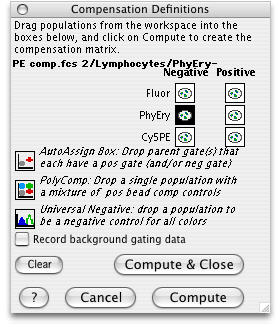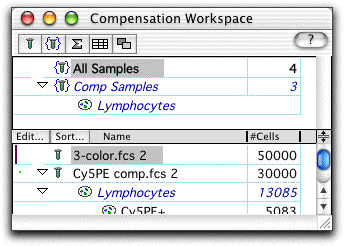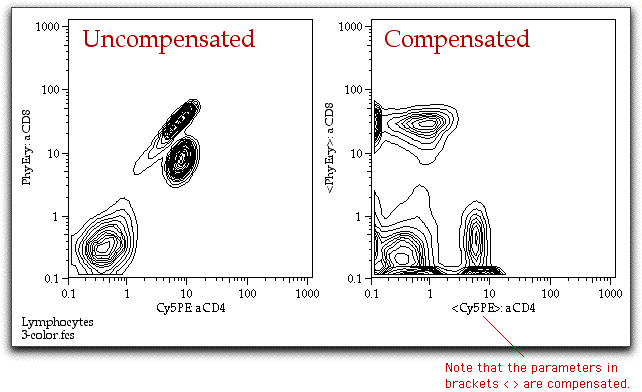Compensation Example: Step 4
Once you have a fully-filled compensation dialog window as shown left, simply click on the Compute or Compute and Close button.

FlowJo now asks you for a name for the compensation matrix. FlowJo
also automatically saves the compensation matrix with the
workspace itself. You can save the matrix to a file because you
may wish to use this matrix for a different workspace (to do this,
select Load Matrix from the Compensate Sample...
> Load Matrix from File... submenu. In addition, you can modify the compensation matrix
yourself .
Once you have computed a matrix, it
will appear in the Compensate Sample... menu
under its own name. To apply it to one or more samples, select the
sample(s) in the Workspace, then select the matrix from the menu.
You can apply it to all samples in a group by selecting the group
followed by selecting the matrix from the menu.

In our example, the matrix we computed is applicable to
all samples in the workspace; thus, we will select the All Samples
group and then select the new compensation matrix. FlowJo lets us
know that the samples are compensated by putting a colored bar
next to the sample nodes.
If we now open a
compensated test sample, we can see the effects of compensation.
First, you will note that there are three new parameters to choose
from in all statistics and graphics. These
three have the fluorescence channel names surrounded by brackets
(<>) to denote that they are compensated; the stain names
(reagent names) are the same as for the uncompensated channels.
See below for a comparison of the uncompensated and compensated
parameters for the test sample (a lymphocyte gate has been applied
already):�
�
One last thing: remember, when you draw gates on
compensated parameters, you can't drag them to an uncompensated
sample (because the parameters don't exist yet!). Remember to
compensate all of your samples before you proceed in your
analysis.
That's all there is to doing
compensation in FlowJo! There is some additional information about
the compensation matrix (its format,
etc.), and on manually changing
the matrix.
Otherwise, you should return to
the compensation overview.�
�
